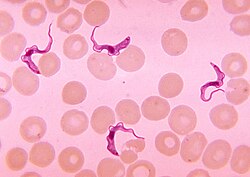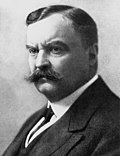Sleeping sickness
- "Sleeping sickness" is also another name for Narcolepsy.

Sleeping sickness, or African trypanosomiasis, is an infectious disease. It is caused by parasites from the species Trypanosoma brucei.
Cause
People get African trypanosomiasis from the tsetse fly. Because of this, it is most common in certain areas of Africa, especially Sub-Saharan Africa, where the tsetse fly lives. Researchers say that about 70 million people, in 36 countries, are at a high risk for getting sleeping sickness.[1]
Epidemiology
As of 2010, sleeping sickness had caused around 9,000 deaths per year (compared to 34,000 in 1990).[2]
In 2013, about 30,000 people had African trypanosomiasis. Also, about 7,000 more people were getting the disease every year.[3] More than 80% of these people in the Democratic Republic of the Congo.[3]
Treatment
Medications can treat African trypanosomiasis. The treatment is usually done in a hospital, because the drugs have many side effects. For sleeping sickness that was not treated early, the medications used for treatment are based on arsenic, a poison. These medications are dangerous, and about 5% of people die from taking them.
Prevention
The best way to protect against African trypanosomiasis is to protect against insect bites.
Signs and symptoms
The signs and symptoms of African trypanosomiasis happen in two stages.
The hemolyphatic phase
Common symptoms in this stage include:
- A fever that comes and goes
- Headaches
- Pain in the joints
- Itching
- Lymphadenopathy: As the parasite gets into the lymphatic system, the body's lymph nodes swell, sometimes to very large sizes
- A chancre (red sore) where the person was bitten by the tsetse fly (sometimes)
If African trypanosomiasis is not treated at this point, the parasite will also get into the circulatory system and defeat the body's natural defenses. If this happens, the person can have:
- Anemia
- Kidney problems
- Problems with hormones
- Heart problems
The neurological phase
This phase begins when the parasite invades the central nervous system by passing through the blood–brain barrier.
In this stage, one of the most common symptoms is trouble sleeping. This is where the name "sleeping sickness" comes from. People in this stage often cannot sleep normally, and may be up all night and then sleep during the day..[4]
Other symptoms in this stage can include:[5]
- Mental confusion
- Tremor
- Muscle weakness
- Weakness or paralysis of an arm or leg
- Movements that the person cannot control, like a person with Parkinson syndrome
- Psychosis
- Feeling easily annoyed or being aggressive
Without treatment, a person with African sleeping sickness will go into a coma; (thus the name) all their important organs will stop working; and they will die.[6]Damage caused in the neurological phase cannot be fixed.[6]
Sleeping Sickness Media
Deaths per 100,000 population due to African trypanosomiasis by country in 2002
In 1903, David Bruce recognized the tsetse fly as the arthropod vector.
References
- ↑ Simarro PP, Cecchi G, Franco JR; et al. (2012). "Estimating and mapping the population at risk of sleeping sickness". PLOS Negl Trop Dis. 6 (10): e1859. doi:10.1371/journal.pntd.0001859. PMC 3493382. PMID 23145192.
{{cite journal}}: CS1 maint: multiple names: authors list (link) - ↑ Lozano, R (15 December 2012). "Global and regional mortality from 235 causes of death for 20 age groups in 1990 and 2010: a systematic analysis for the Global Burden of Disease Study 2010". Lancet. 380 (9859): 2095–128. doi:10.1016/S0140-6736(12)61728-0. hdl:10292/13775. PMC 10790329. PMID 23245604. S2CID 1541253.
{{cite journal}}: Check|pmc=value (help)[dead link] - ↑ 3.0 3.1 WHO Media centre (March 2014). "Fact sheet N°259: Trypanosomiasis, Human African (sleeping sickness)". World Health Organization. Retrieved 25 April 2014.
- ↑ GB Lundkvist, K Kristensson, M Bentivoglio (2004). "Why Trypanosomes Cause Sleeping Sickness". Physiology. 19 (4): 198–206. doi:10.1152/physiol.00006.2004. PMID 15304634.
{{cite journal}}: CS1 maint: multiple names: authors list (link) - ↑ Brun R, Blum J, Chappuis F, Burri C (January 2010). "Human African trypanosomiasis". Lancet. 375 (9709): 148–59. doi:10.1016/S0140-6736(09)60829-1. PMID 19833383. S2CID 39433996.
{{cite journal}}: CS1 maint: multiple names: authors list (link) - ↑ 6.0 6.1 "East African Trypanosomiasis FAQs". Parasites — African Trypanosomiasis (also known as Sleeping Sickness). Centers for Disease Control and Prevention. 29 August 2012.






